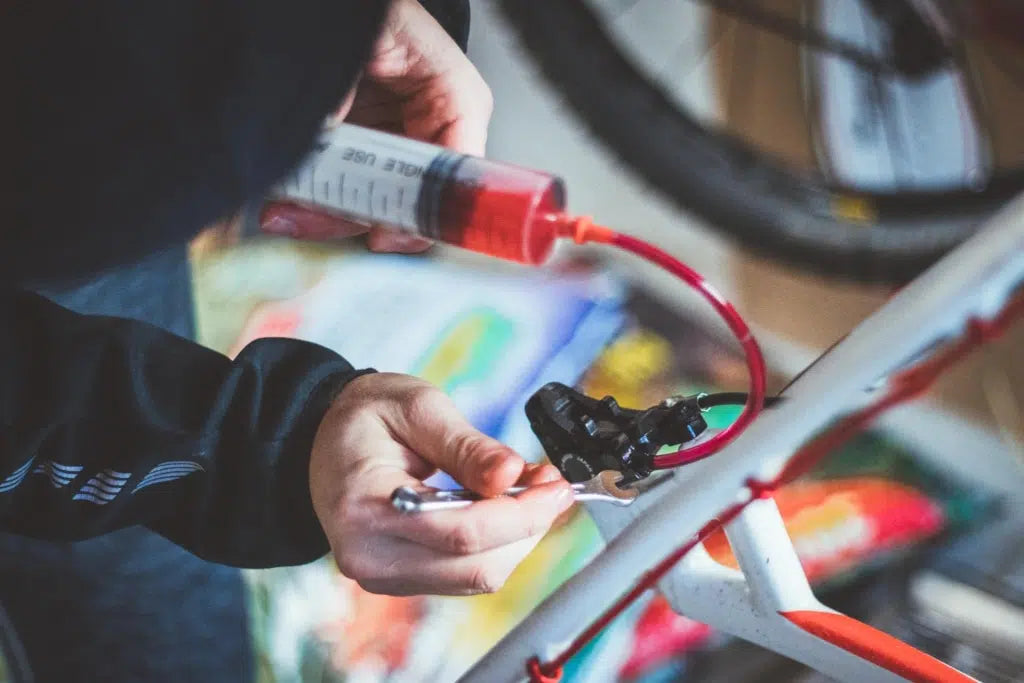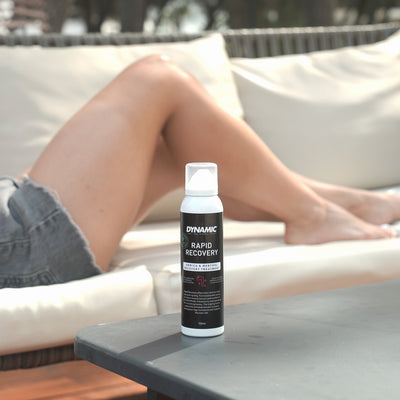Not only mountainbikes are equipped with hydraulic disc brakes, but now also many road bikes and gravel bikes. Hydraulic disc brakes are particularly known for their fast response. They are very robust and allow the braking force to be controlled and dosed well. However, without good maintenance, hydraulic disc brakes loose their positive characteristics. We show you how to easily maintain and bleed your hydraulic disc brakes.
Contents
When do hydraulic disc brakes need to be serviced?
If the braking power of the bikes brakes decreases, you should definitely look for the cause. The brakes on a bike are safety-critical components and should therefore always function properly.
There are usually 3 reasons why the braking power of hydraulic disc brakes decreases:
- The brake pads are worn: In this case you should replace them.
- The brake discs and/or brake pads are dirty: We have instructions on how to clean your brakes.
- There is air in the brake system and the pressure point changes: In this case you should bleed your brakes.
In general, we recommend bleeding the brakes if the pressure point wanders or becomes spongy. Replace the entire brake fluid if it has been in use for a long time. We recommend to check the brake system at least once a year, regardless of its performance. You can do this as part of a spring check.
Checking the pressure point of hydraulic disc brakes
First pump up the brake that you want to service and bleed. To accomplish this, press the brake lever a few times. It may be that the brake can be pressed hard at first. This often happens when the bike has been standing or stored upright for a long time. After you have pumped the brake, the pressure should be built up relatively quickly via the brake. If this happens after about one third of the brake lever travel (or later), there is too much air in the system.

The equipment
To be able to service hydraulic disc brakes on your own, you need special equipment. However, this only needs to be purchased once and can be used again and again. The various brake manufacturers offer complete replacement kits. Depending on the manufacturer, these are shaped slightly differently. But as a rule, a replacement kit for hydraulic disc brakes consists of the following components:
- Syringe
- Cup / container with stopper
- Hoses
- Brake fluid
- Allen key
As already mentioned, you can use this set several times. If you require new brake fluid, you can also use our high-quality hydraulic mineral oil. The mineral oil from Dynamic is safe to use with the various mineral oil brake systems of all manufacturers.
Don’t use this product on DOT Brake Fluid systems!
We also recommend that you have the following equipment ready:
- Absorbent rags
- A container
- Screwdriver / hexagonal spanner

Preparation for the maintenance of hydraulic disc brakes
We recommend using an assembly stand for maintenance, a second person for help might be usefull.
After clamping the bike to the stand, remove the wheels and place it away from the bike to prevent oil to drip onto the rotors during maintenance. You should also remove the brake pads so that they do not get any oil on them. The bicycle should be clamped in the assembly stand in a position in which the bleed nipple of the brake to be bled is at the highest point. You can also attach a bleed block to the brake so that the pistons are pressed outwards and remain well sealed.


Bleeding the hydraulic disc brake correctly
First, loosen the bleed nipples on the brake caliper and the brake lever. Sometimes this is a little more difficult. Using Mechanics Magic can make it easier to loosen the bleed nipples.
Where the bleed screw on the brake lever was unscrewed, you can attach the container with plug for the brake fluid. Ideally, you should have a second person with you to hold this container and the handlebar straight. It is important that the reservoir is sealed and that no air gets into the system.
Next, fill the syringe with about two-thirds of the mineral oil using the bleed hose. Make sure you push the air completely out of the syringe by turning it upwards and pushing until you reach the liquid.

Place the appropriate open-end or ring spanner on the hexagon of the bleed screw on the brake calliper. The hose is now attached to the bleed screw on the brake piston. Make sure that it does not slip off. We recommend that you place a container underneath the brake piston. After attaching it, you can pull the plug from the top of the handlebar into the reservoir. You can leave it in the container.
Now open the screw by a quarter turn at the most, and press the piston of the syringe very slowly and evenly. Tap the hose lightly with the ring spanner. Now the reservoir on the handlebar should fill with oil. If there is air in the system, air bubbles will also be visible there. Do not pull the brake lever during this process! Squeeze as much brake fluid out of the syringe until no more bubbles come out at the top. Then close the screw on the brake calliper again and remove the hose. Take a cloth in your hand and make sure that the oil does not spread everywhere.
The colour of the fluid in the reservoir on the handlebars will also tell you how long it has been since it was serviced. If the fluid is dark, it should definitely be changed.

Remove residual air from the system
Now you can slowly pull the brake lever 2-3 times and release it again. A helping hand would also be an advantage here. The remaining air should come out of the system. You can also tap the brake line and the brake body with a spanner. This often helps to bleed the brake cleanly.
When you are satisfied with the braking point, the plug goes back into the reservoir to close it securely. The reservoir can now be removed and the old oil discarded. Make sure that you dispose the old oil properly.
Additionally, flush brake line (optional)
Now that the brake system has been filled with new oil, the brake line can also be bled in the other direction. This means that you fill fresh oil into the reservoir and attach it to the handlebars again. The plug remains stuck for the time being.
A hose is now attached to the bottom of the brake caliper again, but this time without a syringe. Place a container under the hose or tie a bag around the end of the hose. Now loosen the bleed screw on the brake calliper again and remove the plug at the top. The oil can now escape downwards through the hose. The reservoir at the top must not become empty, otherwise air will enter the system again. When no more air bubbles come out at the bottom, the system can be completely closed again, and then the hose can be dismantled. The oil that has now escaped is new oil that can be poured back into the oil bottle.
After maintenance
When your brake has a suitable pressure point again, you can return the brake lever to its original position. We recommend that you clean the brake discs with brake cleaner before you clamp the bike back into the frame.
Now you should brake-in your brakes properly again.
No improvement after bleed brakes
It is possible that the bleeding did not work 100%. In any case, you should try again and be careful. If the pressure point has not improved after repeated bleeding, you can check the seals.
Shop the Dynamic Hydraulic Mineral Oil here!
After washing your bike, it is important to dry the drivetrain and your frame to prevent corrosion. You can use the Dynamic microfibre cloths or a towel for this. The black microfibre cloth in particular is useful for drying your chain and cassette. This cloth is also suitable for cleaning your brake discs.
If you want to give your frame a protective finish after washing, it is important to use a soft, clean cloth. You can polish the spray with the Luxury Polishing cloth.
Related blog posts




